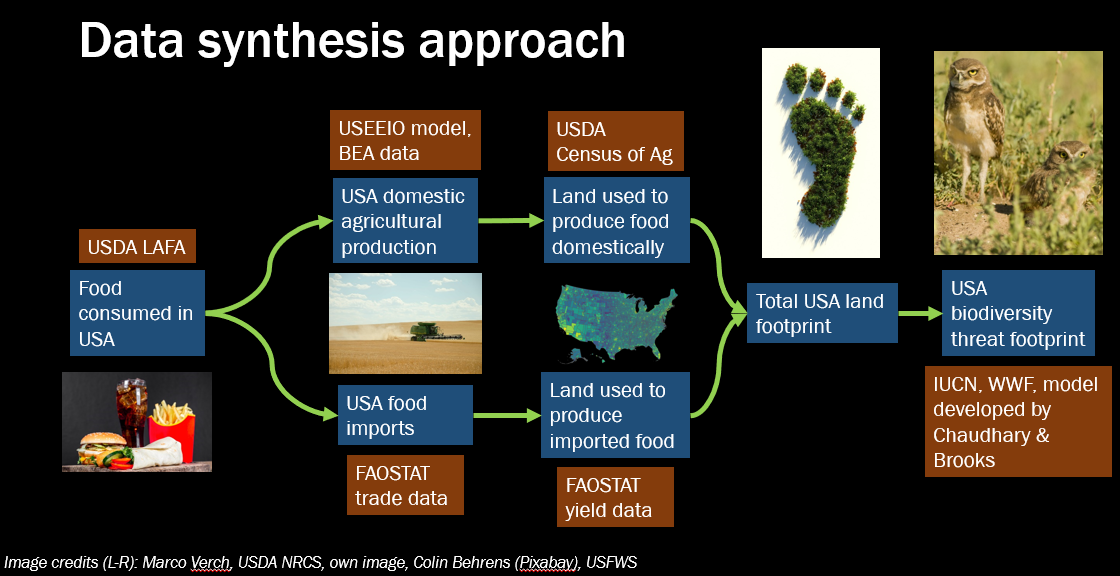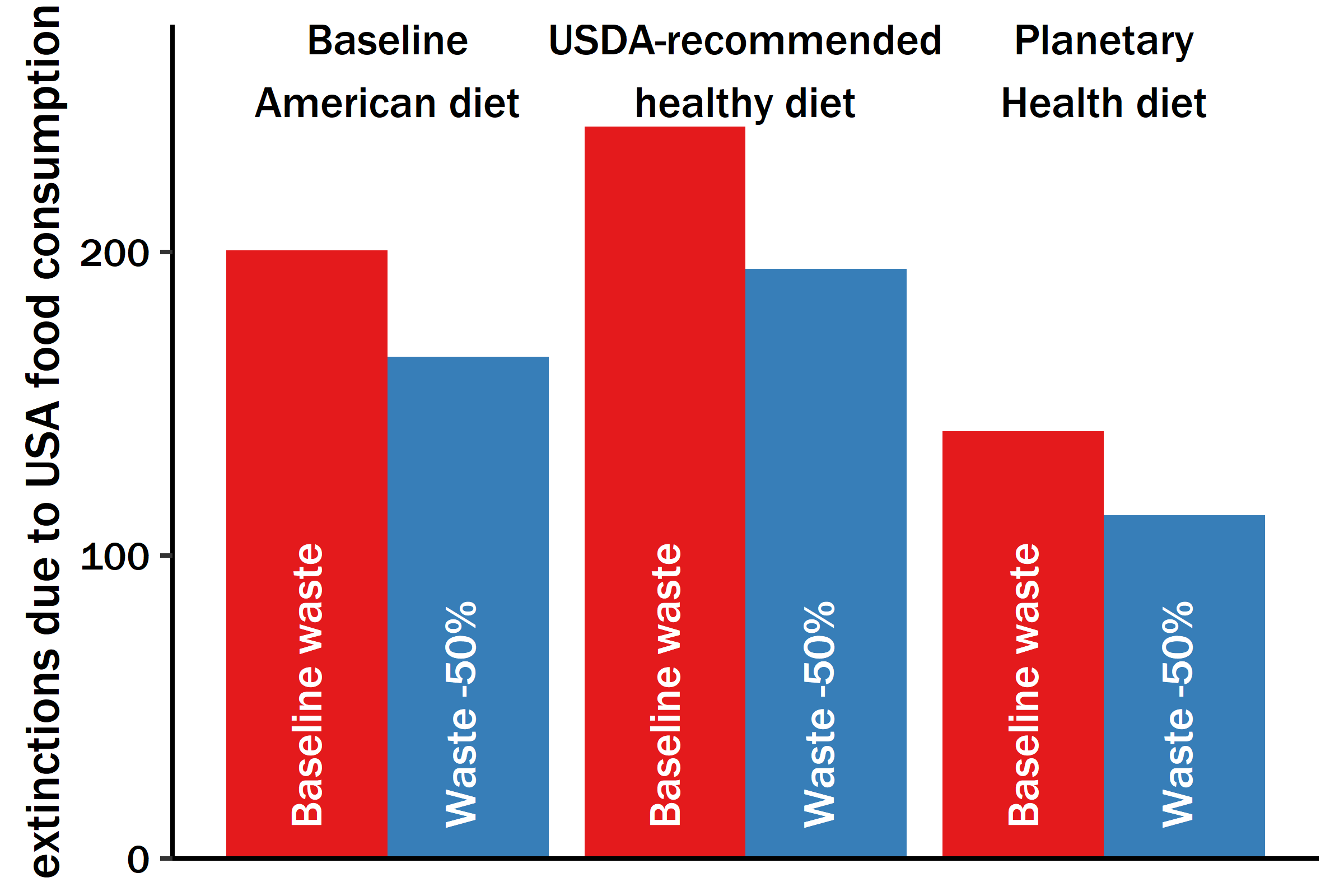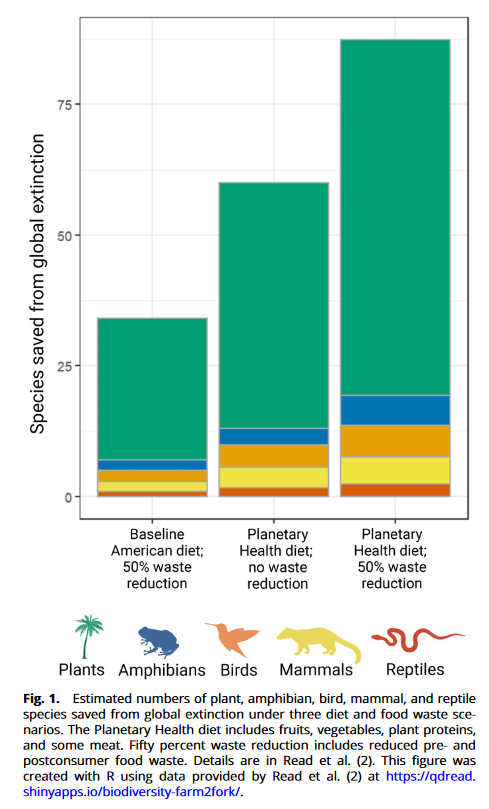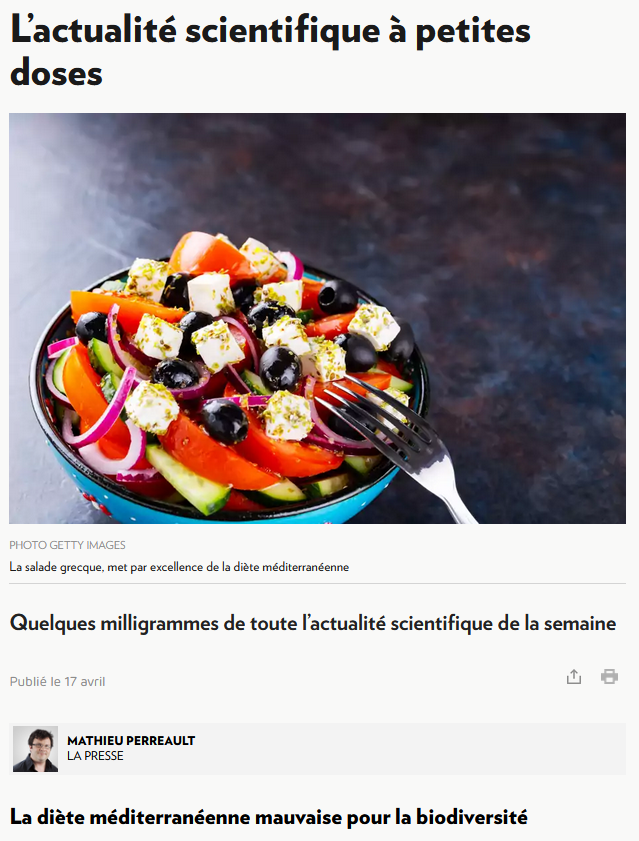How can we reduce the “biodiversity footprint” of the food we eat?
Published:
Recently we published a study about how food waste and food consumption in the United States affect biodiversity around the globe. In this post I’ll tell a little bit about the study, what we found, and an interesting headline that came out about it.
Recently, my former postdoc mentor Mary Muth, my amazing colleague and collaborator Kelly Hondula, and I published a paper about xxx. Out of all the work I’ve done in my professional career so far, it’s the one I’m most excited about and proudest of. But not all the results turned out quite the way we expected — and we were lucky enough to get a smidgen of media attention for the work, which complicates the picture further.
The study
Here’s a link to the actual paper in the journal PNAS as well as a really great two-page synopsis written by Felicia Keesing for PNAS. If you can’t access these because of a paywall, please email me and I will share them with you.

We put together a bunch of different models and data about food consumption in the United States and its environmental impact. First, we figured out how much land is used in each county of the United States, and each country around the world, to produce food that people in the United States consume. Because of our globalized food system and our ability as affluent consumers to purchase expensive imported food, a full 20% of the land used to produce food in the USA is actually in other countries. Next, we converted that land footprint into a biodiversity footprint: when land is converted from natural habitat to agricultural uses, it takes away resources that animals and plants need to sustain their own populations. Even if species don’t immediately go extinct when portions of their habitat are taken away, some species might not have enough land left to keep up a stable population size. So some of them might be “doomed” to eventual extinction if they don’t get some of that land back. We used a few different models … and a lot of assumptions … to get an estimate of the number of plant, mammal, bird, amphibian, and reptile species threatened in this way by Americans’ food consumption habits.
The next thing we did was run those baseline numbers through a few different scenarios. We imagined hypothetical situations where food waste was cut by 50% in the USA, meaning that Americans’ consumption habits could be sustained with less land. We also imagined that overnight, all Americans switched their diet to conform with either the Dietary Guidelines of the USDA and Dept. of Health and Human Services, or the Planetary Health diet recommended by the Lancet commission. What would the consequences of those changes be for the land and biodiversity threat footprint of the American diet?
You probably know the Dietary Guidelines from the old-school food pyramid, which has now been changed to “MyPlate.gov.” There are actually three recommended diets from those guidelines. One is called healthy US-style, one is healthy Mediterranean-style, and the third is healthy vegetarian. They aren’t explicitly supposed to be sustainable, but they are all supposed to be healthy. They all recommend eating less meat than Americans do now, and more fruit, veggies, and nuts. The veggie diet has plenty of animal products in the form of dairy and eggs, though, and the Med-style diet has a decent amount of seafood. By contrast, the Planetary Health diet is supposed to be both healthy and sustainable, with very little animal products in its daily allowance, but lots of fruit, grains, and nuts.
The results

What did we find? Well, we found, unsurprisingly, that food consumption in the United States has a hefty land footprint both inside and outside the nation’s borders. The largest contributor to the land footprint is the pastureland used to raise beef and dairy cattle and farmland to grow the crops used to produce animal feed. However, even though permanent crops like fruit and nut trees occupy only a small fraction of the agricultural land used to produce Americans’ food, that land tends to be more intensively managed, which is more harmful to local biodiversity, and located in parts of the country and world that have higher biodiversity. This leads to a disproportionately high threat to biodiversity from those “specialty” crops, which include things like coffee and chocolate grown in the tropics and fruit and nuts from California, Florida, and Hawaii.
So far, that’s not a particularly new or groundbreaking result. The interesting spin we put on it is to combine this result with simulations of “alternate realities” where the USA takes steps to improve the health and sustainability of American diets. Again, two (if not the two) ways of doing that are to reduce food waste and to change the composition of the average American diet. When we ran those scenarios, we found that while the healthy diets that replace meat mostly with dairy and seafood (the US-style and Mediterranean-style diets) use somewhat less land overall, it actually would have negative consequences for biodiversity if every American ate according to those recommendations. This is because replacing animal products with other animal products does not really change much of the impact, as well as because those diets replace some of the meat and added sugars and fats with fruit and nuts. Those fruits and nuts have to be produced somewhere and if we assume it will require expanding the land footprint in high-biodiversity areas, that will be harmful to the populations of plants and animals that live there. Similarly, even the vegetarian and Planetary Health diets, while they would greatly reduce the land footprint of agriculture by using a lot less pastureland, would not reduce biodiversity threat by as much as you would think just from adding up the land totals. Again this is because of their high requirement of fruit and nuts to replace animal-based sources of nutrition.

However, the results still indicate clearly that plant-based diets are the way to go for reducing the harmful impacts of the USA’s food consumption on biodiversity. The other interesting result is just how well food waste reduction stacks up against these extreme diet changes (that most Americans would probably strongly resist). Cutting food waste in half, and assuming that reduction in demand would reduce food production, could take enough pressure off agricultural land to save X% of the species that are under threat of extinction from American food consumption. That’s a great bang for your buck, especially when you consider that switching everyone in the USA to a vegetarian or Planetary Health diet would reduce that same threat by X%. That isn’t that much more for something that would be incredibly difficult to do — even the mere suggestion of the Planetary Health diet provoked a gigantic backlash when it was proposed. By a similar token, if we wanted to shift our average diet to a healthier (but not as hated by the meat and dairy industries) one that has a little bit worse of an impact on biodiversity, we could more than offset that impact by cutting food waste in half. That’s really important because that would mean overcoming the unfortunate need to choose between what’s healthy for ourselves and for the planet.
The headlines

We were lucky enough to get a little bit of media attention for this paper. I know it’s silly to chase publications in high-profile journals but I guess that is the point: a few of those journals do get looked at by people outside the ivory tower. We even got a brief blurb in the weekly science news column in La Presse, Montreal’s daily paper (link in French only!) I thought it was interesting how they chose to portray the results. The headline proclaims “Mediterranean Diet Bad For Biodiversity” (!) I guess I don’t completely disagree with that but it was a little surprising that that was the result the journalist chose to focus on. I tried to put a more positive spin on things in the actual paper, focusing on potential benefits of actions society could take. But the headline is certainly not incorrect based on the results we got. Well, the only quibble is that the diet in the dietary guidelines is called Mediterranean-style, not just Mediterranean. That’s probably because it includes a good amount more dairy and red meat than what is typically thought of as a true Mediterranean diet with more grains and fish. But that speaks to the different ways in which the creators of the dietary guidelines are pulled, because of the different mandates of the USDA and DHHS. It’s hard to satisfy sustainability, health, and the profitability of agriculture all at the same time.
I can’t complain because not that many scientific papers get any attention at all outside of the academic literature. At first I felt a little uncomfortable that the work was being used to say that healthy diets might not be good for biodiversity, but I think it’s important to stand by the results you get whether or not they support your prior beliefs or agenda. At least, that’s the ideal of objectivity that scientists always brag about but don’t actually live up to that often. At the end of the day, we did show that plant-based diets are beneficial for biodiversity, just not quite in proportion to the amount of land they could spare. It really points more to the need to consider the sources of calories in any diet and source them more intelligently. Biodiversity is unequally distributed across the globe so it makes sense for us to prioritize our food consumption to avoid overexploiting the most biodiversity-rich places and minimize the impact on biodiversity. And of course food waste reduction can help make that task a bit easier.
By the way the paper also got a longer write-up in Anthropocene Magazine which you might be interested in.

Leave a Comment